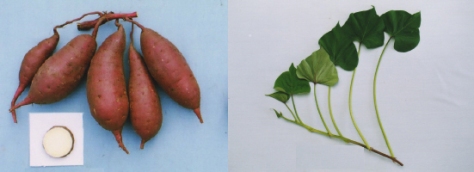
Yams or “Satsuma Imo” were first introduced to Japan in the Ryukyu Islands (Okinawa) in 1604 by the Chinese. They were then introduced in Kyushu in 1609, an area that grows 80% of the total Japanese production.
Ssweet potatoes should not be confused with yams or yama imo/山芋 in Japanese.
They have been recognized in this country for a long time for both their nutritional and pharmaceutical values.

FACTS:
-Season: September~November
-Analytic data (as per 100g):
Energy: 132 kcal
Water: 66.1 g
Proteins: 1.2 g
Carbohydrates: 31.5 g
Inorganic qualities:
Natrium: 4 mg
Potassium: 470 mg
Magnesium: 40 mg
Iron: 0.7 mg
Copper: 0.18 mg
Manganese: 0.44 g
Vitamins:
B1: 0.11mg
C: 29 mg
E: 1.6 mg
Dietary fibers: 2.3 g
HEALTH FACTS:
-Combined with burdock root, or shiitake, or carrot, or spinach, helps combat colds, helps enhance skin health, helps combat lung and intestine cancer.
-Combined with devil’s tongue tuber-elephant foot tuber/konnyku, or hijiki sweet seaweeed, or beansprouts, or apple, helps combat cancer, constipation, obesity, and artery hardening.
-Combined with Judas Ear mushroom, or shiitake, or seaweed, or hijiki sweet seaweed, helps lower blood cholesterol, helps combat obesity and diabetes.
-Combined with strawberries, or lemon, or pimentos, helps combat stress, helps skin rejuvenation and intensifies appetite.
VARIETIES
There are over a hundred species in Japan, but the most popular edible ones (not the ones exclusively used for making shochu) have red skins and light yellow flesh.
Beni Azuma/ベニアズマ, mostly eaten in Eastern Japan. Turns very sweet upon cooking.
Naruto Kintoki/鳴門金時, popular in Western Japan. Considered elegant and sweet.
Tosabeni/土佐紅, also attributed “No 14 value (top)”, is very sweet and is a “brand name” sweet potato.
Cheese cake combination with Tosabeni Sweet Potato!
Manamusume,/愛娘 another “No 14 value” brand sweeet potato.
Gorou Shima Kintoki/五郎島金時, particularly popular as baked sweet potato.
Kougane Sengan/黄金千貫, considered as the top shochu sweet potato.
Tanegashima Mukashi Mitsu Imo/種子島昔蜜芋, a sweet potao with a beautiful orange colour and elegant taste.
Tanegashima Murasaki Imo/種子島紫芋, as above, but with a beautiful purple colour.
Annou Imo/安納いも, rich in carotens, with a beautiful orange colour and very sweet.
Annou Imo cuisine!
Purple Sweet Road/パープルスイートロード, an interesting name for a sweet tasty hybrid.
The same as above as hyokan Japanese jelly!

A favorite “Tanegashima Gold Imo” grown in Taneko Island south of Kyushu. It has the particularity of being red when raw before changing to a rich golden color when cooked. Among other varieties, the violet sweet potatoes are getting increasingly popular.

Tanekoshima sweet potato (deep yellow), “common sweet potato” (light yellow) and Murasaki/Violet potato.
A great combination of the three above as a cold salad with mayonnaise or cream-based dressing.
TIPS:
-Choose specimens with nice color and a “fat/roundish” aspect!
-Plunge yam in cold water as soon as you have cut them. They will not lose their color!
-Boil, bake or steam long enough before taking skin off. Discard skin!
-Leaves can be eaten!
RECOMMENDED RELATED SITES:
Warren Bobrow, Bread + Butter, Zoy Zhang, Hungry Neko, Think Twice, Frank Fariello, Mangantayon, Hapabento, Elinluv Tidbit Corner, Tokyo Terrace, Maison de Christina, Chrys Niles,Lexi, Culinary Musings, Wheeling Gourmet, Comestiblog, Chronicles Of A Curious Cook, Tokyo Through The Drinking Glass, Tokyo Foodcast, Palate To Pen, Yellin Yakimono Gallery, Tokyo Terrace, Hilah Cooking, More than a Mount Full, Arkonite Bento, Happy Little Bento; 5 Star Foodie; Jefferson’s Table; Oyster Culture; Gourmet Fury; Island Vittles; Good Beer & Country Boys; Rubber Slippers In Italy; Color Food daidokoro/Osaka;/a; The Witchy Kitchen; Citron Et Vanille, Lunsj Med Buffet/Estonian Gastronomy (English), Cook, Eat, Play, Repeat, Chrisoscope, Agrigraph, The Agriculture Portal to shizuoka!












